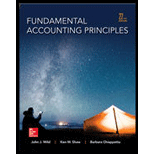
Issue of bond at discount:
When the coupon rate or contract rate of a bond is lower than the market interest rate, the bond is being issued at discount. The selling price of the bond will be lower than the face value of the bond under issue of bond at discount.
Under straight line amortization method, a specific amount of discount is amortized each period till its maturity period. The period ending amortization amount is computed by dividing the total discount by the number of periods in maturity of the bonds payable.
To determine:
1. Preparation of
2. Compute the total bond interest expense to be recognized over the life of the bonds.
3. Prepare the first two years of an amortization table using straight-line method.
4. Prepare the journal entries to record the first two interest payments.
5. Describe how the amounts reported on Legacy’s financial statement will be affected if the market rate on January 1, 2015, is 4% instead of 8%.
Answer to Problem 5APSA
Solution:
1.
| Date | Accounts | Debit | Credit |
| 2015 | |||
| Jan. 1 | Cash | $292,181 | |
| Discount on Bonds Payable | $32,819 | ||
| Bonds Payable | $325,000 |
2. The total bond interest expense to be recognized over the bond’s life is $97,819.
3.
| Period Ending | Unamortized Discount | Carrying Value |
| 01/1/2015 | $32,819 | $292,181 |
| 06/30/2015 | $28,717 | $296,283 |
| 12/31/2015 | $24,615 | $300,385 |
| 06/30/2016 | $20,513 | $304,487 |
| 12/31/2016 | $16,411 | $308,589 |
4.
| Date | General Journal | Debit | Credit |
| 2015 | |||
| Jun. 30 | Interest Expense | $12,225 | |
| Cash | $8,125 | ||
| Discount on Bonds Payable | $4,102 | ||
| Dec. 31 | Interest Expense | $12,225 | |
| Cash | $8,125 | ||
| Discount on Bonds Payable | $4,102 |
5.
If the bonds were issued at market rate of 4% instead of 8%, the issue of bonds payable is on premium which will amortized every semiannual period over the life of the bonds. On the financial statement of the Legacy, the interest expense will be lesser and the interest payment in cash will greater. On the
Explanation of Solution
Explanation:
1.
| Computation of discount on bonds | |
| Par | $325,000 |
| Issue price of bonds payable | $292,181 |
| Discount on bonds payable | $32,819 |
2.
| Computation of total interest expense | |
| Amount to be repaid at maturity: | |
| Total Interest Payment | $65,000 |
| Par Value of Bonds | $325,000 |
| Total amount to be repaid | $390,000 |
| Less : Selling Price of the Bonds | $292,181 |
| Total Bond Interest Expense | $97,819 |
3.
4.
5. If the coupon rate of the bonds payable is more than the market rate, the issue is considered to be on premium.
Conclusion:
The total interest expense over the bond’s life of Legacy is $97,819 and every semiannual period a discount of $4,102 is amortized.
Want to see more full solutions like this?
Chapter 14 Solutions
Fundamental Accounting Principles -Hardcover
- Bruno Manufacturing uses direct labor-hours in its predetermined overhead rate. At the beginning of the year, the total estimated manufacturing overhead was $680,000. At the end of the year, actual direct labor-hours for the year were 42,500 hours, manufacturing overhead for the year was underapplied by $25,500, and the actual manufacturing overhead was $695,000. The predetermined overhead rate for the year must have been closest to: A) $16.00 B) $15.75 C) $16.35 D) $16.94arrow_forwardWhat was manufactured overhead?arrow_forwardWhich of the following choices is the correct status of manufacturing overhead at year-end?arrow_forward

 AccountingAccountingISBN:9781337272094Author:WARREN, Carl S., Reeve, James M., Duchac, Jonathan E.Publisher:Cengage Learning,
AccountingAccountingISBN:9781337272094Author:WARREN, Carl S., Reeve, James M., Duchac, Jonathan E.Publisher:Cengage Learning, Accounting Information SystemsAccountingISBN:9781337619202Author:Hall, James A.Publisher:Cengage Learning,
Accounting Information SystemsAccountingISBN:9781337619202Author:Hall, James A.Publisher:Cengage Learning, Horngren's Cost Accounting: A Managerial Emphasis...AccountingISBN:9780134475585Author:Srikant M. Datar, Madhav V. RajanPublisher:PEARSON
Horngren's Cost Accounting: A Managerial Emphasis...AccountingISBN:9780134475585Author:Srikant M. Datar, Madhav V. RajanPublisher:PEARSON Intermediate AccountingAccountingISBN:9781259722660Author:J. David Spiceland, Mark W. Nelson, Wayne M ThomasPublisher:McGraw-Hill Education
Intermediate AccountingAccountingISBN:9781259722660Author:J. David Spiceland, Mark W. Nelson, Wayne M ThomasPublisher:McGraw-Hill Education Financial and Managerial AccountingAccountingISBN:9781259726705Author:John J Wild, Ken W. Shaw, Barbara Chiappetta Fundamental Accounting PrinciplesPublisher:McGraw-Hill Education
Financial and Managerial AccountingAccountingISBN:9781259726705Author:John J Wild, Ken W. Shaw, Barbara Chiappetta Fundamental Accounting PrinciplesPublisher:McGraw-Hill Education





